Fiber optic lighting uses only a single light source, typically a 5-15 watt LED housed in a small fan-cooled box sheltered from the elements. Light travels on slender, flexible cables that end in points of light — small emitters that you insert into holes drilled in your decking. Because there’s no electricity or heat conducted, the cables and light are safe in any type of weather. Installing fiber optic lighting is a good DIY project. A kit with 120 emitters and cables is about $325.
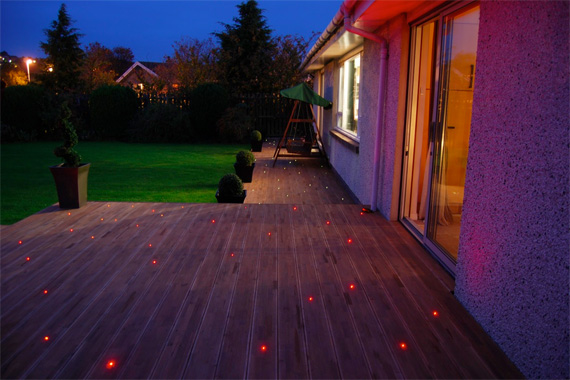
Credit: Starscape Fibre Optic & LED Lighting
Lighting the Way
Deck lighting extends party time on your deck, and adds safety, too. Fixtures on posts offer ambient lighting and signal the railing location. Low-voltage LED light fixtures run on 12-volt current that’s much safer than regular 120-volt household current, making installation DIY-friendly. Make the posts from pieces of lumber so there’s a hollow channel inside; run low-voltage wiring in the channel. A lighting kit with 8 fixtures, wire, and a 12-volt transformer is $587.
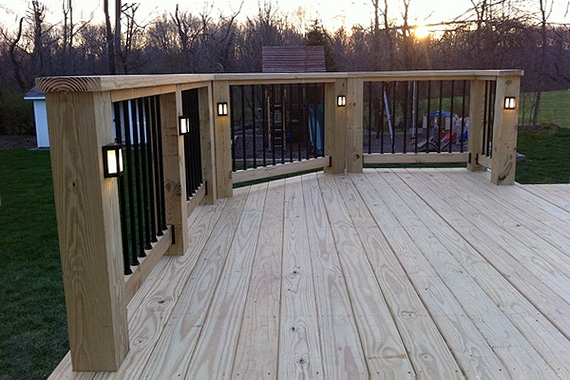
Credit: Highpoint Deck Lighting
Moveable Lighting
An oversize floor lamp made for outdoor use will light up an entire deck seating area with its 250-watt halogen bulb. A plastic shade, galvanized steel frame, and aluminum base make this fixture weatherproof. Six lead weights keep it stable in windy conditions. It’s a plug-in lamp, so you’ll need a weatherproof outdoor outlet — a minor concession for this $13,750 outdoor fixture.
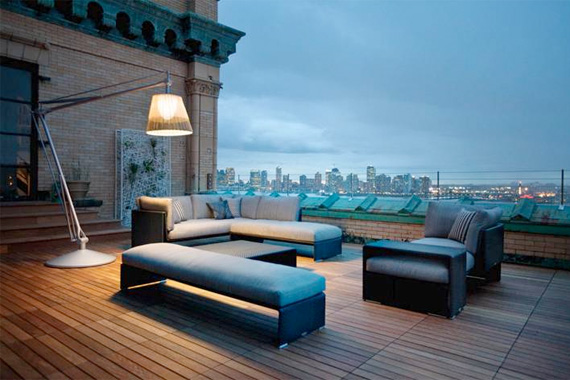
Credit: SuperArchiMoon/Designed by Philippe Starck for DEDON/Photo courtesy of Dedon
Low-Voltage Wonderland
Most exterior landscape lighting — including railing lights and uplighting for trees — is low-voltage. A low-voltage system uses a transformer to convert regular 120-volt household current into 12-volt current. With less power, however, exterior lights may be dimmer than you expect. That’s why it’s important that your transformer is sized for your lighting scheme. Buy a transformer ($100-$200) that plugs into an outdoor outlet, or have an electrician install one for about $400.
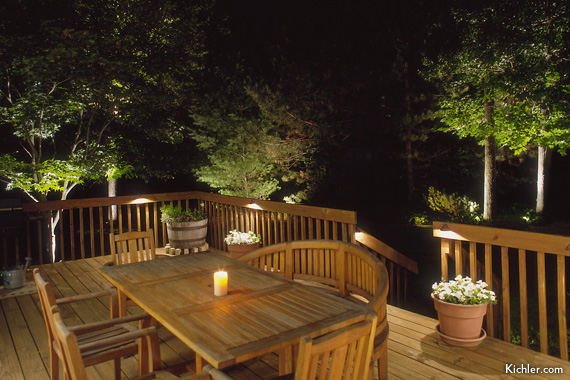
Credit: Kichler
Way-Easy Deck Lighting
String lights offer versatility and style — they go up in any location, there’s no need to conceal wiring (it’s part of the lights), and they come in tons of styles and sizes. You can choose standard lights that plug directly into an outlet, or low-voltage lights that use 12-volt current. Outdoor solar-powered lights cost a bit more initially but don’t use household power and aren’t dependent on a nearby power source. A 14-ft.-long string with 20 solar-powered LED lights is about $20.
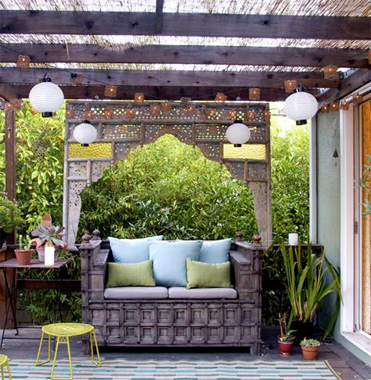
Credit: Taylor de Cordoba
Keepin’ it Cool
A combination light and ceiling fan brings a welcome cooling breeze to the warmest days. You’ll need to run a 120-volt circuit to power your outdoor fan; use the juice to power other outdoor lights as well. Concealing the wires isn’t difficult with the solid ceiling shown here; for an open pergola or arbor, run wires on top of or alongside framing members and paint them to match the woodwork.
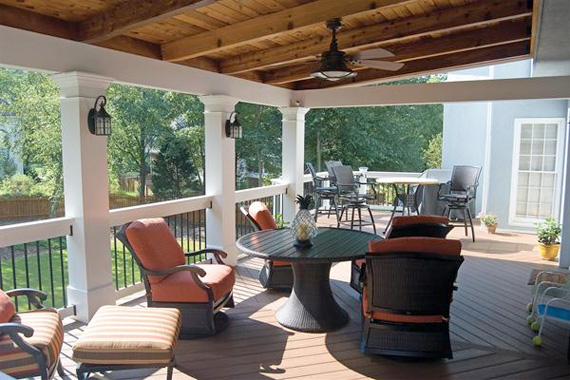
Credit: Peachtree Decks and Porches LLC
A Light Meal
An outdoor kitchen adds a lot of enjoyment to your deck or patio, but be sure to include lighting that lets you flip burgers when the sun goes down. Almost every type of fixture is available in a weatherproof outdoor version — wall sconces, track lights, and recessed lighting. Putting your outdoor lights on dimmers helps you adjust for mood and tasks.
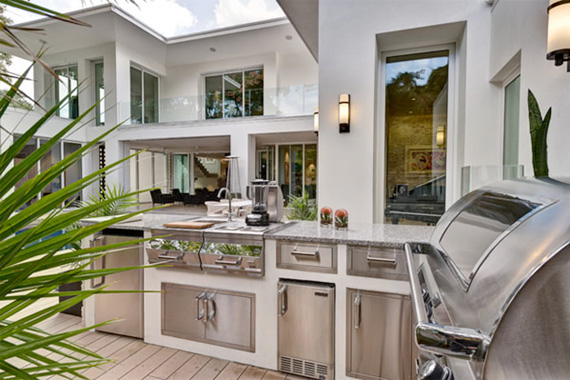
Credit: Phil Kean Designs/James Wilson, photo/Courtesy BUILDER
Practical Safety
In some municipalities, lighting exterior stairways for entrances, decks, and patios is required by building codes. An easy way to add this sensible safety measure is with motion-activated lighting. The battery-operated lights shown here install anywhere using screws or double-sided tape. A bright LED light comes on when motion is detected up to 8 feet away, and stays on for 30 seconds. Battery life is good for about a year. $40 for a set of 3 lights; the AAA batteries aren’t included.
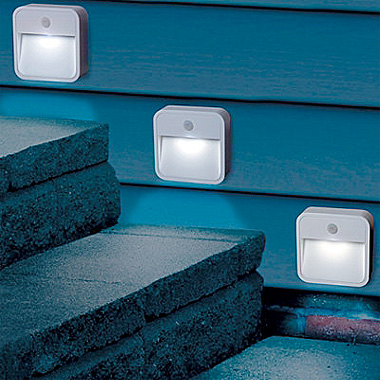
Credit: Improvements Catalog / HSN
Directional Lighting That’s Sea Turtle Safe
When illuminating stairs and walkways, fixtures should cast light downward at the walking surface — not upward into eyes. These low-voltage railing lights have hoods that project light down for safety. Because they’re in use at the seashore, these particular fixtures feature amber LED bulbs that won’t attract and confuse endangered baby sea turtles. The lights ($218 each) feature solid brass hoods and marine-grade wiring to resist corrosion.
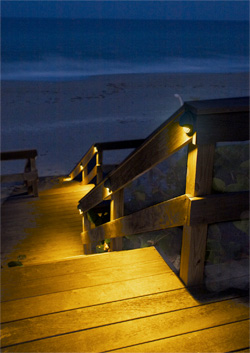
Credit: CAST Lighting
Today, You’re Purple
Express your every mood, color-wise, with RGB LED lighting. The RGB stands for red, green, and blue. By using a computerized controller, you can mix the RGB output to produce any color in the rainbow — and a few that aren’t. Outdoor RGB LED light fixtures come as waterproof strips and bars. You’ll need a transformer to provide the low-voltage current needed for your LED lights, and a waterproof location for the controller. A kit with 8 feet of strip lights costs about $275.

Credit: Robert Krten
See-Through Lighting
Tempered safety glass has been used for deck balusters for years, but these glass panels go one step further. LED lights in the top and bottom caps illuminate the glass surface and cast a gentle ambient light. The panels ($230 each) feature etchings that catch the light to create a unique, decorative touch. Most glass balusters are compliant with building codes, but check your local codes to be sure.
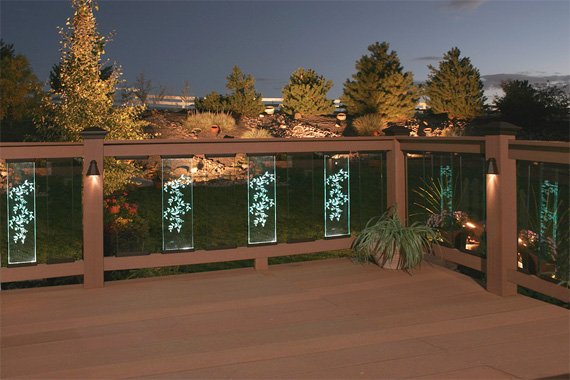
Credit: Dekor
Source: HouseLogic

No comments:
Post a Comment